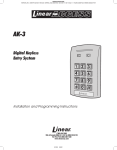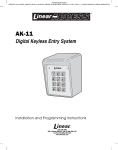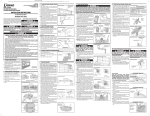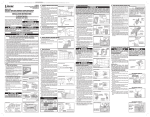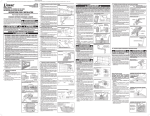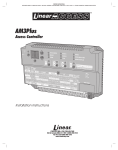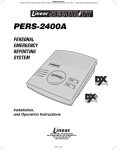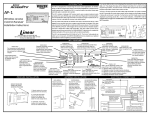Download Linear AKR-1 User's Manual
Transcript
PRINTER’S INSTRUCTIONS: INSTR,INSTL,AKR-1 - LINEAR P/N: 217350 D - INK: BLACK - MATERIAL: 20 LB. MEAD BOND - SIZE: 7.000” X 4.750” - SCALE: 1-1 - FOLDING: ALBUM-FOLD - BINDING: SADDLE-STITCH AKR-1 Digital Keyless Entry System With Built-in Wireless Receiver Installation and Programming Instructions (760) 438-7000 • FAX (760) 438-7043 USA & Canada (800) 421-1587 & (800) 392-0123 Toll Free FAX (800) 468-1340 www.linearcorp.com 217350 D IMAGE 1 CONTENTS FEATURES . . . . . . . . . . . . . . . . . . . . . . . . . . . . . . . . . . . . . . . . . . . 1 INSTALLATION . . . . . . . . . . . . . . . . . . . . . . . . . . . . . . . . . . . . . . . . 1 COMPONENT LOCATIONS . . . . . . . . . . . . . . . . . . . . . . . . . . . . . . . . 2 WIRING DIAGRAM . . . . . . . . . . . . . . . . . . . . . . . . . . . . . . . . . . . . 3 FACTORY DEFAULTS . . . . . . . . . . . . . . . . . . . . . . . . . . . . . . . . . . . . 7 BASIC PROGRAMMING . . . . . . . . . . . . . . . . . . . . . . . . . . . . . . . . . 7 PROGRAMMING OPTIONS . . . . . . . . . . . . . . . . . . . . . . . . . . . . . . . 8 RADIO PROGRAMMING. . . . . . . . . . . . . . . . . . . . . . . . . . . . . . . . 11 AKR-1 OPERATION . . . . . . . . . . . . . . . . . . . . . . . . . . . . . . . . . . . 15 MGT OBSTACLE TRANSMITTER OPERATION . . . . . . . . . . . . . . . . . . 16 RADIO TEST MODE. . . . . . . . . . . . . . . . . . . . . . . . . . . . . . . . . . . . 16 SPECIFICATIONS. . . . . . . . . . . . . . . . . . . . . . . . . . . . . . . . . . . . . . 17 LINEAR LIMITED WARRANTY . . . . . . . . . . . . . . . . . . . . . . . . . . . . 17 IMPORTANT !!! . . . . . . . . . . . . . . . . . . . . . . . . . . . . . . . . . . . . . . 18 FCC NOTICE . . . . . . . . . . . . . . . . . . . . . . . . . . . . . . . . . . . . . . . . . 18 PRODUCT DESCRIPTION Linear’s AKR-1 is a digital keyless entry system with a built-in radio receiver designed for access control applications. The keypad is housed in a rugged, cast aluminum enclosure that can be mounted to a pedestal or bolted directly to a wall. The die-cast keys have bright, easy-to-read yellow graphics. Up to 480 entry codes, from 1 to 6 digits in length, can be programmed. They can activate either, or both, of the relay outputs. Relay #1 has a 5 Amp capacity. Relay #2 has a 1 Amp capacity. Up to four sets of block coded MegaCode® transmitters (up to 480 transmitters total) can be used to gain access through the AKR-1’s built-in radio receiver. Each transmitter can be individually suspended or re-activated. Four facility codes can be programmed to identify each block of transmitters. A Radio Test Mode is provided for testing transmitters and detecting radio interference. Programming of individual (non-block coded) transmitters is not supported by the AKR-1. Linear’s Model MGT safety edge transmitter is compatible with the AKR-1. This supervised transmitter is used to detect and transmit obstacle events to the AKR-1 receiver. Obstacle signals from an MGT transmitter will activate Relay #2. Two indicators show the status of the entry system. The left indicator lights red to indicate power, then turns green when access is granted. The right indicator lights yellow when the keypad is in “lockout” condition (from too many incorrect code entries). The keypad’s courtesy light illuminates the keys for two minutes after any key is pressed. An internal sounder beeps when each key is pressed and when a transmitter is granted access. An internal jumper sets the sounder volume high or low. The DOOR SENSE/INHIBIT input can be used two ways. If programmed for “door sense”, a switch on the door detects forced entry or door ajar situations. If programmed for “inhibit”, the input can be wired to a “service” switch or automatic timer that will disable the Relay #1 when required. The REQUEST-TO-ENTER input can be wired to a pushbutton or fire access keyswitch to provide codeless entry for authorized personnel. The “anti-passback” feature prevents using the same code or the same transmitter again before the programmed time elapses. The ALARM SHUNT output activates when access is granted. This output can be wired to shunt alarm contacts on the access door/gate to prevent triggering of an alarm when authorized access occurs. Two solid state outputs, capable of switching 100 mA to common, are programmable to signal forced entry, door ajar, lockout, alarm circuit shunting, request-to-enter, and keypad active conditions. The AKR-1 is powered from a 12-24 Volt AC or DC source. Power can be obtained from the access device or a separate power supply. The EEPROM memory retains all entry codes, transmitter information, and programming, even without power. An internal jumper is provided to reset the master code. 217350 D IMAGE 2 FEATURES ✓ ✓ ✓ ✓ ✓ ✓ ✓ ✓ ✓ ✓ ✓ ✓ ✓ ✓ ✓ ✓ ✓ ✓ ✓ ✓ ✓ INSTALLATION KEYPAD PROGRAMMABLE 480 ENTRY CODE CAPACITY 480 TRANSMITTER CAPACITY SUPPORTS 4 BLOCKS OF TRANSMITTERS WITH 4 FACILITY CODES WEATHER-PROOF, TAMPER-RESISTANT RADIO ANTENNA SUPPORTS 1 MODEL MGT SAFETY EDGE TRANSMITTER 1-6 DIGIT ENTRY CODE LENGTH 4 INDEPENDENT OUTPUTS (TIMED/TOGGLED) 4 INDEPENDENT TIMERS EACH ENTRY CODE CAN BE PROGRAMMED TO ACTIVATE EITHER OR BOTH RELAYS RELAY CONTACTS ARE FORM “C” (N.O. & N.C) SOLID STATE OUTPUTS ARE OPEN COLLECTOR (SWITCH-TO-COMMON) TWO STATUS INDICATORS COURTESY LAMP PIEZO SOUNDER TIMED ANTI-PASSBACK (LAST 3 VALID ENTRIES) KEYPAD LOCKOUT TACTILE KEY FEEL DOOR SENSE INPUT INHIBIT INPUT REQUEST-TO-ENTER INPUT To avoid damage to the unit from static discharges, connect the EARTH GROUND terminal to a good earth grounding point. Suggested wiring size is 18 AWG for earth ground and power (up to 500 feet of 18 AWG wire can be run for power, use larger wire for longer runs). Use 22 AWG or larger (depending on the load) for all other connections. ✦ CAUTION: If the unit is AC powered, and one side of the power transformer secondary is connected to earth ground, connect the grounded side to the “-” power terminal of the unit. Select a location for the keypad. For door access control installations, mount the keypad near the controlled door. For gate control installations, mount the keypad in clear view of the gate, but far enough from the gate so the user cannot touch the gate from the keypad. ★ WARNING: TO AVOID SERIOUS INJURY OR DEATH, MAKE SURE THAT THE UNIT IS FAR ENOUGH FROM THE GATE SO THAT THE USER CANNOT TOUCH THE GATE WHILE OPERATING THE KEYPAD. HOWEVER, THE GATE MUST BE FULLY VISIBLE FROM THE KEYPAD. 1 217350 D IMAGE 3 COMPONENT LOCATIONS RED/GREEN POWER/ACCESS INDICATOR ANTENNA (HIDDEN) YELLOW "LOCKOUT" INDICATOR JUMPER JP2 REMOVE TO RESET MASTER CODE TERMINAL BLOCK NIGHT LIGHT TACTILE KEYPAD JUMPER JP1 REMOVE TO REDUCE BEEPER SOUND KEYLOCK Figure 1. Component Locations 2 217350 D IMAGE 4 WIRING DIAGRAM TYPICAL GATE INSTALLATION WIRING TYPICAL DOOR INSTALLATION WIRING AKR-1 TERMINALS MAIN RELAY N.O. 1 COMMON 2 AKR-1 TERMINALS OPEN N.C. 3 OUTPUT #3 4 OUTPUT #4 5 GATE OPERATOR TRANSFORMER ISOLATED AUXILIARY POWER 6 DC OR AC POWER AUXILIARY RELAY MAIN RELAY 7 N.O. 1 COMMON 2 N.C. 3 OUTPUT #3 4 OUTPUT #4 5 6 DC OR AC POWER 8 COMMON 8 N.O. 9 N.O. 9 AUXILIARY RELAY COMMON 10 FIRE ACCESS COMMON 10 COMMON 13 INHIBIT 14 EARTH GROUND 15 NOTES: 1. ALARM SHUNT SET FOR AUXILIARY RELAY 2. TERMINAL 14 SET FOR DOOR SENSE GROUND STAKE DOOR SWITCH DOOR SENSE 14 INHIBIT TIMER EARTH GROUND 15 CAUTION OPTIONAL WIRING TO ALARM SYSTEM REQUEST-TO-ENTER 12 COMMON 13 REQUIRED WIRING ALARM CONTACT N.C. 11 REQUEST-TO-ENTER 12 NOTE: TERMINAL 14 SET FOR INHIBIT POWER SUPPLY 7 COMMON N.C. 11 ELECTRIC DOOR STRIKE IF THE UNIT IS AC POWERED, AND ONE SIDE OF THE POWER TRANSFORMER SECONDARY IS CONNECTED TO EARTH GROUND, CONNECT THE GROUNDED SIDE TO THE "-" POWER TERMINAL OF THE UNIT. GROUND STAKE REQUIRED WIRING OPTIONAL WIRING OTHER WIRING 3 217350 D IMAGE 5 Pedestal Mounting Wall Mounting The AKR-1 keypad can be mounted on a standard pedestal. ❑ Use four security bolts and locking nuts to secure the keypad’s backplate to the pedestal (see Figure 3). The AKR-1 keypad can be mounted directly to a wall or flat surface. ❑ Use the appropriate fasteners to secure the keypad’s backplate to the mounting surface. ❑ When mounting the keypad to a concrete wall, use concrete wedge anchors or molly anchors (see Figure 4). WALL MOUNTING PEDESTAL USE CONCRETE WEDGE ANCHORS OR MOLLY ANCHORS MOUNT BACKPLATE WITH SECURITY BOLTS AND LOCKNUTS Figure 3. Pedestal Mounting Keypad Backplate Figure 4. Wall Mounting Keypad Backplate 4 217350 D IMAGE 6 Gate Control Refer to Figure 5 for an outline of a typical gate installation. ❑ Route four wires between the gate and the keypad (two for power, two for control). ❑ Connect the gate operator’s auxiliary or radio power output terminals to the keypads POWER input terminals (observe wiring polarity). ❑ Connect the gate operator’s OPEN terminals to the keypad’s Relay #1 COMMON & N.O. terminals. ☞ NOTE: For operator wiring specifics, refer to the gate operator’s wiring diagram. ❑ If a request-to-enter pushbutton or fire access keyswitch is going to be used, route two wires from the keypad to the normally open switch. Connect the wires to the normally open switch and to the keypad’s REQUEST-TO-ENTER and COMMON terminals. ❑ If an inhibit switch or timer is going to be used, route two wires from the keypad to the inhibit switch or timer relay. Connect the inhibit switch/timer terminals to the keypad’s INHIBIT and COMMON terminals. ☞ NOTE: If the INHIBIT input is going to be used, it must be programmed to select that input type. See the Programming Options section of this manual AKR-1 KEYPAD FIRE ACCESS KEYSWITCH GATE OPERATOR (BEHIND GATE) 2 WIRES FOR REQUEST-TO-ENTER 2 WIRES FROM AKR-1 TO TRIGGER GATE OPEN 2 WIRES FROM OPERATOR FOR AKR-1 POWER Figure 5. Gate Installation 5 217350 D IMAGE 7 Door Control ❑ Install a low voltage electric door strike for unlocking the door. ❑ Choose a location for the power supply or transformer. ❑ Route two wires between the power supply and the keypad. Connect the power supply’s output terminals to the keypad’s POWER input terminals (observe wiring polarity). ❑ Route two wires between the door strike and the keypad. Connect one of the door strike wires to the keypad’s Relay #1 N.O. terminal. Connect the other door strike wire to the keypad’s POWER + terminal. Connect a wire between the keypad’s POWER - terminal and the Relay #1 COMMON terminal. ❑ If a request-to-enter pushbutton or fire access keyswitch is going to be used, route two wires from the keypad to the normally open switch. Connect the wires to the normally open switch and to the keypad’s REQUEST-TO-ENTER and COMMON terminals. ❑ To use the door sense feature to detect forced entry or door ajar conditions, install a normally closed door switch on the door and route two wires from the switch to the keypad. Connect the door switch to the keypad’s DOOR SENSE and COMMON terminals. ❑ If an inhibit switch or timer is going to be used, route two wires from the switch or timer to the keypad. Connect the inhibit switch/timer terminals to the keypad’s INHIBIT and COMMON terminals. ☞ NOTE: Either door sense or inhibit can be used. Both features cannot be used at the same time. DOOR SENSE SWITCH 2 WIRES FOR DOOR SENSE AKR-1 KEYPAD 2 WIRES FOR POWER ELECTRIC DOOR STRIKE 2 WIRES FOR DOOR STRIKE Figure 6. Door Installation 6 217350 D IMAGE 8 FROM POWER SUPPLY FACTORY DEFAULTS BASIC PROGRAMMING MASTER PROGRAMMING CODE . . . . . . . . . . . . . . . . . . . . . . . . . . . . . . . . . . . . . . . 123456 ENTRY CODE LENGTH . . . . . . . . . . . . . . . . . . . . . . . . . . . . . . . . . . . . . . . . . . . . . 4 DIGITS REQUEST-TO-ENTER OUTPUT . . . . . . . . . . . . . . . . . . . . . . . . . . . . . . . . . . . . . . . . RELAY #1 ALARM SHUNT OUTPUT . . . . . . . . . . . . . . . . . . . . . . . . . . . . . . . . . . . . . . . . . . DISABLED FORCED ENTRY OUTPUT . . . . . . . . . . . . . . . . . . . . . . . . . . . . . . . . . . . . . . . . . OUTPUT #3 DOOR AJAR OUTPUT. . . . . . . . . . . . . . . . . . . . . . . . . . . . . . . . . . . . . . . . . . . . OUTPUT #4 RELAY #1 ON TIME . . . . . . . . . . . . . . . . . . . . . . . . . . . . . . . . . . . . . . . . . . . . . 2 SECONDS RELAY #2 ON TIME . . . . . . . . . . . . . . . . . . . . . . . . . . . . . . . . . . . . . . . . . . . . . 2 SECONDS SOLID STATE OUTPUT #3 ON TIME . . . . . . . . . . . . . . . . . . . . . . . . . . . . . . . . . . 2 SECONDS SOLID STATE OUTPUT #4 ON TIME . . . . . . . . . . . . . . . . . . . . . . . . . . . . . . . . . . 2 SECONDS DOOR SENSE/INHIBIT INPUT . . . . . . . . . . . . . . . . . . . . . . . . . . . . . . . . . . . . DOOR SENSE KEYPAD LOCKOUT OUTPUT . . . . . . . . . . . . . . . . . . . . . . . . . . . . . . . . . . . . . . . . DISABLED KEYPAD ACTIVE OUTPUT . . . . . . . . . . . . . . . . . . . . . . . . . . . . . . . . . . . . . . . . . . DISABLED BEEPER SOUNDS WHEN KEY PRESSED . . . . . . . . . . . . . . . . . . . . . . . . . . . . . . . . . . . . . YES BEEPER SOUNDS DURING RELAY #1 . . . . . . . . . . . . . . . . . . . . . . . . . . . . . . . . . . . . . . NO BEEPER SOUNDS DURING RELAY #2 . . . . . . . . . . . . . . . . . . . . . . . . . . . . . . . . . . . . . . NO BEEPER SOUNDS DURING OUTPUT #3 . . . . . . . . . . . . . . . . . . . . . . . . . . . . . . . . . . . . . NO BEEPER SOUNDS DURING OUTPUT #4 . . . . . . . . . . . . . . . . . . . . . . . . . . . . . . . . . . . . . NO KEYPAD LOCKOUT COUNT . . . . . . . . . . . . . . . . . . . . . . . . . . . . . 3 TRIES BEFORE LOCKOUT ANTI-PASSBACK TIME . . . . . . . . . . . . . . . . . . . . . . . . . . . . . . . . . . . . . NO ANTI-PASSBACK TRANSMITTER LEFT BUTTON ACTIVATES . . . . . . . . . . . . . . . . . . . . . . . . . . . . . . . . RELAY #1 TRANSMITTER RIGHT BUTTON ACTIVATES . . . . . . . . . . . . . . . . . . . . . . . . . . . . . . . RELAY #2 TRANSMITTER TOP BUTTON ACTIVATES. . . . . . . . . . . . . . . . . . . . . . . . . . . . . . . . . . . NONE TRANSMITTER LOWER LEFT BUTTON ACTIVATES . . . . . . . . . . . . . . . . . . . . . . . . . . . . NONE TRANSMITTER LOWER RIGHT BUTTON ACTIVATES . . . . . . . . . . . . . . . . . . . . . . . . . . . NONE When the AKR-1 is in Programming Mode, both indicators will turn off until programming begins. After a programming option number is entered the yellow indicator will blink. This shows that the AKR-1 is ready to accept the new programming data. After the new data entry is complete, the green indicator will light while the data is being stored.The red indicator will light if any programming data is entered incorrectly, and the command will have to be fully re-entered. Entering Programming Mode The 6-digit Master Programming Code (default = 123456) is used to enter Programming Mode. Press: # 9 # Master Code Master Code = the current 6-digit Master Programming Code Exiting Programming Mode Press: **# The red indicator will light when Programming Mode is exited. ☞ NOTE: The AKR-1 will automatically exit Programming Mode after two minutes of inactivity. Re-entering a Command After a Mistake If the red indicator lights, signaling an incorrect entry, or an incorrect key is pressed during programming, to clear the keypad and re-enter the command: Press: * 9 # Setting Entry Code Length Default: 4 digits Press: 0 3 # Length # Length = 1 - 6 for entry code length ☞ NOTE: If the Entry Code Length is going to be changed from the factory default of four digits, make this change first, before programming any entry codes. 7 217350 D IMAGE 9 Adding a New Entry Code Press: 0 1 # Code # Code # Relay # Code = The new entry code: 1-999999, depending on code length Relay = Relay output entry code will activate: 1 = Relay #1 2 = Relay #2 3 = Both Relays The yellow indicator will flash quickly while the AKR-1 searches its memory for available space and duplicate entries. The green indicator will light when the new code is stored. If the new entry code chosen is already being used for another entry code, the red indicator will light. A new unique code needs to be entered. ☞ NOTE: Leading zeros (zeros before the code number, i.e. 0001) do not need to be entered when programming a new entry code. The AKR-1 will internally add any zeros to fill all digits determined by the entry code length setting. Leading zeros will have to be entered by the user when entering their code to gain access. Erasing a Single Entry Code PROGRAMMING OPTIONS There are several AKR-1 programming options. For most installations, the factory set default options are sufficient. The keypad must be in Programming Mode to make these changes. Programming AKR-1 to Hold the Output Linear’s AccessKey products have a programmable “Toggle Mode” available for each relay and solid-state output. When an output is programmed for Toggle Mode, the output alternates from OFF to ON or from ON to OFF each time it is activated. The rules for a toggle output are: • If the output is OFF, it will turn ON and stay on until the next activation. • If the output is ON, it will turn OFF and stay off until the next activation. Typical Programming With the unit in Program Mode, set the Auxiliary Relay (Relay #2) output to Toggle Mode using the following keystrokes: Press: 0 2 # Code # Code # Code = The entry code to delete. The yellow indicator will flash quickly while the AKR-1 searches its memory for the code to erase. The green indicator will light when the code is erased. Erasing All Entry Codes ★ WARNING: Performing this command will remove all entry codes from the memory. Press: 9 7 # 0 0 0 0 0 0 # 0 0 0 0 0 0 # ☞ NOTE: The green indicator will light while the memory is being erased. This may take up to 15 seconds. Changing the 6-Digit Master Programming Code Press: 9 8 # Master Code # Master Code # Master Code = The new 6-digit Master Programming Code New master code: _____________________ Press: 2 2 # 9 9 # 22 = Programming Step; 99 = Toggle Mode Program all normal entry codes to use the Main Relay (Relay #1), and only Relay #1 as the output relay. Program the code(s) that you want to use to hold the output for an indefinite period to the Auxiliary Relay (Relay #2). See the following example that sets entry codes 1234 for normal and 5678 for toggle operation. 1234 NORMAL ENTRY CODE Press: 0 1 # 1 2 3 4 # 1 2 3 4 # 1 # 5678 TOGGLE ENTRY CODE Press: 0 1 # 5 6 7 8 # 5 6 7 8 # 2 # 8 217350 D IMAGE 10 01 = Programming Step; 1234 = Entry Code; 1 = Main Relay 01 = Programming Step; 5678 = Entry Code; 2 = Auxiliary Relay Typical Toggle Mode Wiring For devices triggered by a normally open circuit, wire the contacts of the Main and Auxiliary Relays in parallel (see the Figure below). Either relay will be able to trigger the access device. Entry codes programmed for the Auxiliary Relay will be able to hold the output on. N.O. MAIN RELAY AKR-1 OUTPUTS AUXILIARY RELAY COMMON Select Forced Entry Output Default: Output #3 Sets which output activates if the DOOR SENSE input opens before access is granted. This output is not timed. Press: 1 1 # Output # Output = Output to Activate (0-4) 1 = Relay #1 2 = Relay #2 3 = Output #3 4 = Output #4 0 = No Output Select Door Ajar Output Default: Output #4 Sets which output activates if the DOOR SENSE input stays open 60 seconds after access is granted. This output is not timed. ACCESS DEVICE N.C. Press: 1 2 # Output # N.O. Output = Output to Activate (0-4) 1 = Relay #1 2 = Relay #2 3 = Output #3 4 = Output #4 0 = No Output COMMON EITHER RELAY CAN TRIGGER THE ACCESS DEVICE Select Keypad Lockout Output Default: No Output Sets which output activates when the keypad is “locked out” after too many incorrect entry code attempts. The lockout time is 60 seconds. N.C. Select Door Sense or Inhibit Input Default: Door Sense The input on Terminal #14 can be programmed for DOOR SENSE or INHIBIT. Press: 1 0 # Input# Input = 0 for Door Sense, = 1 for Inhibit When programmed for DOOR SENSE, if an open condition on the input occurs before access is granted (with an entry code, transmitter or with the request-toenter input) a FORCED ENTRY output will occur. If an open condition remains 60 seconds after a relay activation for access, a DOOR AJAR output will occur. When programmed for INHIBIT, a closed condition on the input will prevent Relay #1 from activating when access is requested (with an entry code or transmitter). This mode is typically used with an external timer to disable the access device at certain times. Press: 1 3 # Output # Output = Output to Activate (0-4) 1 = Relay #1 2 = Relay #2 3 = Output #3 4 = Output #4 0 = No Output Select Keypad Active Output Default: No Output Sets which output activates when any keys are pressed. This output is timed. If toggle mode is selected for the output, the timer value defaults to 2 seconds. Press: 1 4 # Output # Output = Output to Activate (0-4) 1 = Relay #1 2 = Relay #2 3 = Output #3 4 = Output #4 0 = No Output 9 217350 D IMAGE 11 Press: 2 4 # Seconds # Select Alarm Shunt Output Default: No Output Sets which output activates during the time access is granted. (Use this output to shunt alarm contacts attached to the access door.) This output may be timed or toggled. Beep Sounds on Keystrokes Default: Yes Selects whether or not the keypad beeps as each key is pressed. Press: 1 5 # Output # Press: 4 0 # Sound # Output = Output to Activate (0-4) 1 = Relay #1 2 = Relay #2 3 = Output #3, 4 = Output #4 0 = No Output Select Request-to-Enter Output Default: Relay #1 Sets which output activates when the Request-to-Enter input is grounded. This output may be timed or toggled. Press: 1 6 # Output # Output = Output to Activate (0-4) 1 = Relay #1 2 = Relay #2 3 = Output #3 4 = Output #4 0 = No Output Seconds = Output time in seconds (0-60), 99 = Toggle mode Sound = 1 for Yes, = 0 for No Beep Sounds During Relay #1 Default: No Selects whether or not the keypad beeps during Relay #1 activation. Press: 4 1 # Sound # Sound = 1 for Yes, = 0 for No Beep Sounds During Relay #2 Default: No Selects whether or not the keypad beeps during Relay #2 activation. Press: 4 2 # Sound # Relay #1 On-time Default: 2 Seconds Sets the length of time Relay #1 activates when triggered. Press: 2 1 # Seconds # Seconds = Output time in seconds (0-60), 99 = Toggle mode Sound = 1 for Yes, = 0 for No Beep Sounds During Output #3 Default: No Selects whether or not the keypad beeps during Output #3 activation. Press: 4 3 # Sound # Relay #2 On-time Default: 2 Seconds Sets the length of time Relay #2 activates when triggered. Press: 2 2 # Seconds # Seconds = Output time in seconds (0-60), 99 = Toggle mode Sound = 1 for Yes, = 0 for No Beep Sounds During Output #4 Default: No Selects whether or not the keypad beeps during Output #4 activation. Press: 4 4 # Sound # Solid-state Output #3 On-time Default: 2 Seconds Sets the length of time Output #3 activates when triggered. Press: 2 3 # Seconds # Seconds = Output time in seconds (0-60), 99 = Toggle mode Sound = 1 for Yes, = 0 for No Keypad Lockout Count Default: 3 Tries Sets the number of incorrect entry code attempts allowed before the keypad “locks out”. Solid-state Output #4 On-time Default: 2 Seconds Sets the length of time Output #4 activates when triggered. Press: 5 0 # Attempts # Attempts = Number of attempts before lockout (2-7) 10 217350 D IMAGE 12 Anti-passback Time Default: No Anti-passback Sets the length of time an entry code or transmitter will not function after it is used. Press: 9 0 # TX ID # Status # Press: 5 1 # Minutes # Selecting the Facility Codes Default: Ignore Facility Code Facility Codes increase security by requiring the Facility Code as well the TX ID code to match before access is granted. Up to four Facility Codes can be entered. The Facility Code number is labeled on the box of block coded transmitters. Enter the Facility Code number (1-15) for each transmitter block added to the AKR-1. Minutes = Time in Minutes (1-4), 0 = No Anti-passback RADIO PROGRAMMING The following programming steps are used to add, remove, suspend, and configure block coded transmitters used with the AKR-1. Programming of individual (non-block coded) transmitters is not supported by the AKR-1. Add Transmitter Block(s) Sets the starting and ending TX ID numbers for up to four blocks of pre-programmed transmitters. Enter this command up to four times to select TX IDs for transmitter blocks one, two, three, and four. Up to 480 transmitters total, distributed in any quantity between the blocks, can be added to the AKR-1’s memory. Press: 8 0 # Start ID # End ID # Start ID = 1-65535 End ID = 1-65535 TX ID = 1-65535 Status = 0 for Suspend, = 1 for Reactivate Press: 6 0 # Location # Code # Location = Facility Code Memory Location (1-4) Code = Facility Code number (1-15), 0 = Ignore transmitter Facility Codes Add MGT Obstacle Transmitter Programs a Model MGT obstacle transmitter into the AKR-1. Locate the MGT ID and facility codes on a label inside the MGT enclosure. See previous section (Selecting the facility codes) to enter the MGT facility code. Refer to the MGT Obstacle Transmitter Operation section of this manual and the MGT Installation Instructions for details on MGT transmitter operation. To enter MGT ID: Press: 9 9 # ID # ID # ID = 1 - 65535 Erase Transmitter Block(s) This command will erase all transmitters from memory. Transmitter blocks cannot be erased individually. Single transmitters can be suspended from operation using the Suspend/Reactivate command. Press: 9 1 # 0 0 0 0 0 0 # 0 0 0 0 0 0 # Suspend/Reactivate an Individual Transmitter This command suspends (prevents transmitter from being used), or reactivates (un-suspends) the designated transmitter. NOTE: This command will effect the first occurrence of the TX ID in memory. If, by rare chance, duplicate TX ID numbers occur in different transmitter blocks, contact Linear Technical Services for details on how to suspend/reactivate individual transmitters. Erase MGT Obstacle Transmitter Removes a Model MGT obstacle transmitter from the AKR-1 memory. Press: 9 5 # 0 0 0 0 0 0 # 0 0 0 0 0 0 # Select Left Button Output Default: Relay #1 Sets which relay output activates when a transmitter’s left button is pressed. This setting effects all transmitters used with the AKR-1. See Figure 7 for transmitter button designations for various models. Press: 7 1 # Output # Output = Output to Activate (0-3) 1 = Relay #1 2 = Relay #2 3 = Both Relays 0 = No Output 11 217350 D IMAGE 13 BOTH FUNCTION AS LEFT BUTTON LEFT BUTTON Select Right Button Output Default: Relay #2 Sets which relay output activates when a transmitter’s right button is pressed. This setting effects all transmitters used with the AKR-1. See Figure 7 for transmitter button designations for various models. LEFT BUTTON Press: 7 2 # Output # ACT-31 Output = Output to Activate (0-3) 1 = Relay #1 2 = Relay #2 3 = Both Relays 0 = No Output SINGLE-CHANNEL TRANSMITTERS MDT ACT-21 TOP BUTTON BOTH EQUALS TOP BUTTON Select Top Button Output Default: No Output Sets which relay output activates when a transmitter’s top button is pressed. This setting effects all transmitters used with the AKR-1. See Figure 7 for transmitter button designations for various models. Press: 7 3 # Output # RIGHT BUTTON Output = Output to Activate (0-3) 1 = Relay #1 2 = Relay #2 3 = Both Relays 0 = No Output RIGHT BUTTON LEFT BUTTON LEFT BUTTON ACT-22 THREE-CHANNEL TRANSMITTERS MDT-2 RIGHT BUTTON BOTTOM-LEFT BUTTON ACT-34 FOUR-CHANNEL TRANSMITTER Press: 7 4 # Output # TOP BUTTON LEFT BUTTON BOTTOM-RIGHT BUTTON Select Bottom-left Button Output Default: No Output Sets which relay output activates when a transmitter’s bottom-left button is pressed. This setting effects all transmitters used with the AKR-1. See Figure 7 for transmitter button designations for various models. RIGHT BUTTON LEFT BUTTON BOTTOM-RIGHT BUTTON BOTTOM-LEFT BUTTON MDT-4 Output = Output to Activate (0-3) 1 = Relay #1 2 = Relay #2 3 = Both Relays 0 = No Output Select Bottom-right Button Output Default: No Output Sets which relay output activates when a transmitter’s bottom-right button is pressed. This setting effects all transmitters used with the AKR-1. See Figure 7 for transmitter button designations for various models. FIVE-CHANNEL TRANSMITTER Press: 7 5 # Output # Output = Output to Activate (0-3) 1 = Relay #1 2 = Relay #2 3 = Both Relays 0 = No Output Figure 7. Transmitter Button Designations 12 217350 D IMAGE 14 Master Reset ✦ CAUTION: Performing a master reset will clear the entire memory of the AKR-1 and return all programmable options to the factory default values. ALL ENTRY CODES AND TRANSMITTERS WILL BE ERASED. STEP 1 Disconnect power from the keypad. STEP 2 Press and hold down the * and # keys. STEP 3 Apply power to the keypad, continue holding the keys down until the red indicator starts flashing. STEP 4 Release the keys. The red and yellow indicators will remain lit until the process is complete, then the yellow indicator will go out. Resetting the Master Code STEP 1 STEP 2 STEP 3 STEP 4 Open the AKR-1 case. Locate jumper JP2. This jumper is used to reset the master code. With power applied to the keypad, remove jumper JP2. The keypad will begin to beep, signaling that the code has been reset. Replace jumper JP2. THE MASTER PROGRAMMING CODE IS NOW 123456. Solid State Outputs The two solid state outputs (Output #3 & Output #4) can be programmed to activate during various conditions. These outputs can be used to activate indicators or sounders. See Figure 8 for wiring examples using the solid state outputs. AKR-1 POWER 6 ELECTRONIC BEEPER 1K 9 1K 9 LED OUTPUT #3 4 OUTPUT #4 5 LED EACH OUTPUT 100 mA MAXIMUM EXAMPLE 1: OUTPUT #3 LIGHTS AN LED, OUTPUT #4 LIGHTS AN LED AND SOUNDS A BEEPER OUTPUT #3 4 OUTPUT #4 5 LOW VOLTAGE LAMP POWER SOURCE EACH OUTPUT 100 mA MAXIMUM N.O. ZONE END-OF-LINE RESISTOR COMMON GROUND 8 ALARM PANEL COMMON EXAMPLE 2: OUTPUT #3 LIGHTS A LAMP POWERED FROM AN EXTERNAL SOURCE, OUTPUT #4 TRIGGERS A NORMALLY OPEN ALARM PANEL ZONE Figure 8. Using Solid State Outputs 13 217350 D IMAGE 15 Beeper Sound Level Locking Keypad The keypad’s beeper can be set to low or high level. ❑ If the keypad’s beeper is too loud for the keypad’s location, remove jumper JP1 (see Figure 9). After the installation is complete. Lock the keypad using the keylock (see Figure 10). REMOVE JUMPER JP1 TO REDUCE THE BEEPER VOLUME HOOK KEYPAD ONTO BACKPLATE USE KEY TO LOCK KEYPAD Figure 10. Locking the Keypad Case Figure 9. Removing the Beeper Jumper 14 217350 D IMAGE 16 AKR-1 OPERATION With Entry Code ❑ Users of the AKR-1 have up to 40 seconds to key in their entry code. ❑ Up to eight seconds are allowed between each keystroke. ❑ All digits of the entry code must be entered. Example: If the code is 0042, the user must enter “0 0 4 2”. ❑ If the wrong key is pressed, pressing the key will reset the * keypad. The correct code can then be re-entered. ❑ After a correct code is entered, the red indicator will turn green and the programmed relay will activate for the programmed time. ❑ If the number of incorrect codes entered exceeds the keypad lockout count, the yellow indicator will light, indicating that the keypad is locked out. The lockout will remain for one minute. ❑ After a valid code has been entered, it will be unusable until the anti-passback time expires. RED LED TURNS GREEN WHEN ACCESS IS GRANTED YELLOW LED WILL LIGHT DURING KEYPAD LOCKOUT IF TOO MANY INCORRECT CODES ARE ENTERED With Wireless Transmitter ❑ Activate a wireless transmitter within radio range (up to 300 feet) of the AKR-1. ❑ After a valid transmitter is decoded, the keypad will beep, the red indicator will turn green, and the programmed relay will activate for the programmed time. ❑ After a transmitter has been used to gain access, it will be unusable until the anti-passback time expires. PRESS STAR KEY TO RESET KEYPAD IF THE WRONG KEY IS PRESSED USERS HAVE UP TO 40 SECONDS TO ENTER THEIR COMPLETE CODE Figure 11. Operating the AKR-1 15 217350 D IMAGE 17 MGT OBSTACLE TRANSMITTER OPERATION RADIO TEST MODE One Model MGT obstacle transmitter can be programmed into the AKR-1. The MGT is triggered with a safety edge contact and will activate the AKR-1 Relay #2 for the programmed length of time. A special mode is provided to test transmitters and determine if there is radio frequency interference present. The keypad will function normally while it is in Radio Test Mode. To enter Radio Test Mode, use the following command: ☞ NOTE: If an MGT transmitter is programmed, all other transmitters or entry code activations programmed for Relay #2 will be blocked. MGT Supervisory Mode If an MGT supervisory condition occurs the AKR-1 will beep every 5 seconds. In addition, all users will have to enter their entry code twice (within one minute), or activate their transmitter twice (within ten seconds) to request access. The MGT can monitor and produce three supervisory conditions: low battery, case tamper/loop fault, and status. To determine the supervisory condition place the AKR-1 in MGT supervisory mode, the same command is used to exit this mode: Press the * , # , and “0” buttons together for two seconds The AKR-1 will beep once when the Radio Test Mode is entered. The keypad’s yellow indicator will blink quickly when radio signals are detected. If a Linear MegaCode transmitter is detected, the AKR-1 will beep once when the transmission is decoded. The AKR-1 will automatically exit Radio Test Mode 45 seconds after the last MegaCode signal is decoded. YELLOW LED WILL FLASH AS RADIO SIGNALS ARE DETECTED Press the * , # , and “2” buttons together for two seconds While in MGT Supervisory Mode, the following conditions can be displayed: Low Battery If the transmitter detects a low battery, it will send a low battery supervisory report. The keypad’s yellow indicator will blink. Tamper/Loop Fault If the transmitter case is opened or the safety edge contact becomes defective, it will send a tamper/loop fault supervisory report. The keypad’s red indicator will blink. Status Status reports are sent every hour. If no status reports are received for eight hours, a status exception condition occurs. The keypad’s green indicator will blink. ACTIVATE TRANSMITTER UNIT WILL BEEP WHEN A MEGACODE TRANSMITTER IS DECODED Figure 12. Radio Test Mode 16 217350 D IMAGE 18 SPECIFICATIONS MECHANICAL Case dimensions: ELECTRICAL Voltage: Current: Outputs: LINEAR LIMITED WARRANTY This Linear product is warranted against defects in material and workmanship for twelve (12) months. The Warranty Expiration Date is labeled on the product. This warranty extends only to wholesale customers who buy direct from Linear or through Linear’s normal distribution channels. Linear does not warrant this product to consumers. Consumers should inquire from their selling dealer as to the nature of the dealer’s warranty, if any. There are no obligations or liabilities on the part of Linear corporation for consequential damages arising out of or in connection with use or performance of this product or other indirect damages with respect to loss of property, revenue, or profit, or cost of removal, installation, or reinstallation. All implied warranties, including implied warranties for merchantability and implied warranties for fitness, are valid only until Warranty Expiration Date as labeled on the product. This Linear Corporation Warranty is in lieu of all other warranties express or implied. All products returned for warranty service require a Return Product Authorization Number (RPA#). Contact Linear Technical Services at 1-800-421-1587 for an RPA# and other important details. 4.00” W x 7.00” H x 3.00” D 12-24 Volts AC or DC 10 mA typical, 150 mA maximum Relay #1 Form “C” 5 Amps @ 24 Volts maximum Relay #2 Form “C” 1 Amp @ 24 Volts maximum Solid state outputs (Outputs #3 & #4) Short-to-common 100 mA @ 24 VDC maximum RADIO Frequency: 318 Mhz ± 500 KHz @ 23°C 318 MHz ± 1 MHz -30°C to +65°C RF 3db Bandwidth: 4 MHz Typical Sensitivity: -95 dBm Minimum Encoding: Linear MegaCode® Format ENVIRONMENTAL Temperature: -22°F to 149°F (-30°C to 65°C) Humidity: 5% to 95% non-condensing 17 217350 D IMAGE 19 IMPORTANT !!! FCC NOTICE Linear radio controls provide a reliable communications link and fill an important need in portable wireless signaling. However, there are some limitations which must be observed. • For U.S. installations only: The radios are required to comply with FCC Rules and Regulations as Part 15 devices. As such, they have limited transmitter power and therefore limited range. • A receiver cannot respond to more than one transmitted signal at a time and may be blocked by radio signals that occur on or near their operating frequencies, regardless of code settings. • Changes or modifications to the device may void FCC compliance. • Infrequently used radio links should be tested regularly to protect against undetected interference or fault. • A general knowledge of radio and its vagaries should be gained prior to acting as a wholesale distributor or dealer, and these facts should be communicated to the ultimate users. Changes or modifications not expressly described in this manual or approved by the manufacturer could void the user’s authority to operate the equipment. This equipment has been tested and found to comply with the limits for a Class B digital device, pursuant to Part 15 of the FCC Rules. These limits are designed to provide reasonable protection against harmful interference in a residential installation. This equipment generates, uses and can radiate radio frequency energy and, if not installed and used in accordance with the instructions, may cause harmful interference to radio communications. However, there is no guarantee that interference will not occur in a particular installation. If this equipment does cause harmful interference to radio or television reception, which can be determined by turning the equipment off and on, the user is encouraged to try to correct the interference by one or more of the following measures: • Reorient or relocate the receiving antenna. • Increase the separation between the equipment and receiver. • Connect the equipment into an outlet on a circuit different from that to which the receiver is connected. • Consult the dealer or an experienced radio/TV technician for help. Copyright © 2002 Linear Corporation 217350 D 217350 D IMAGE 20





















